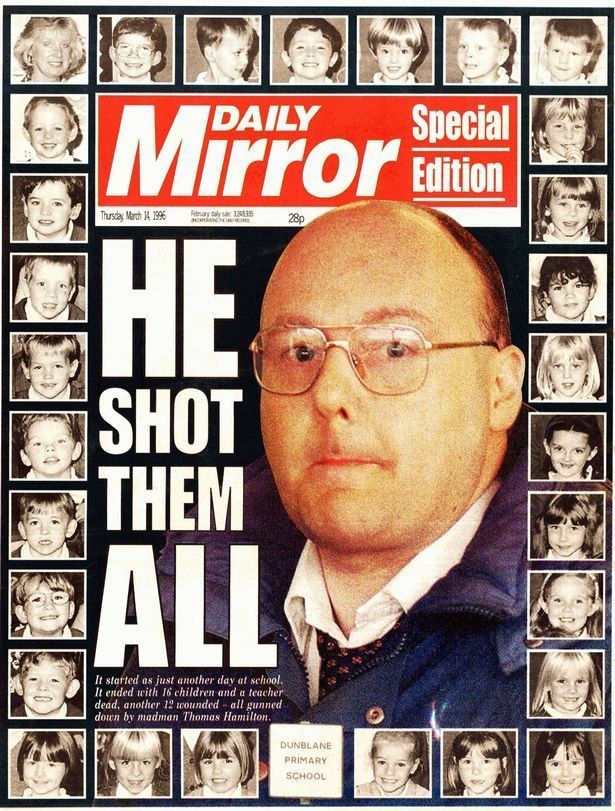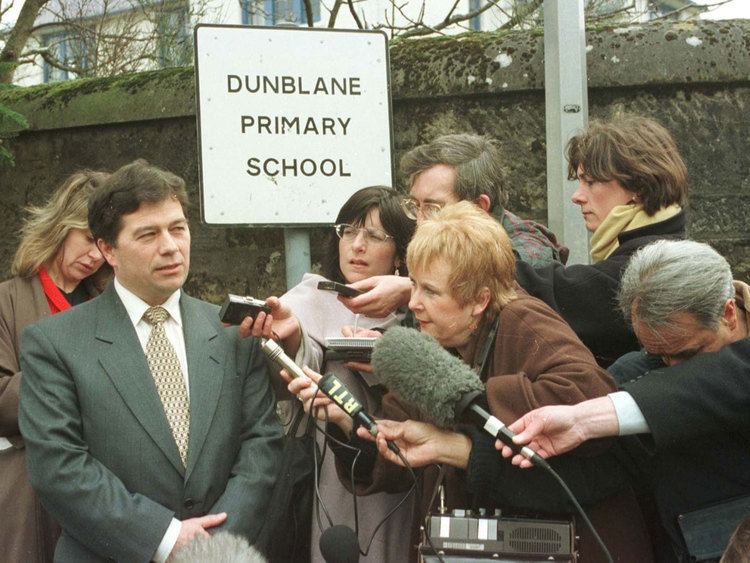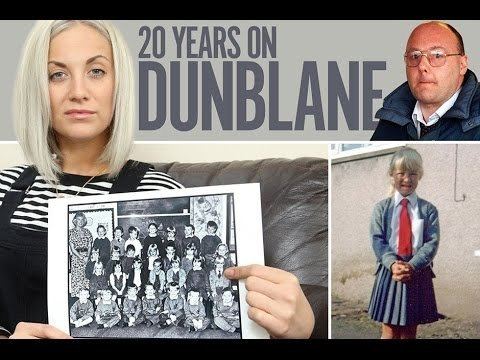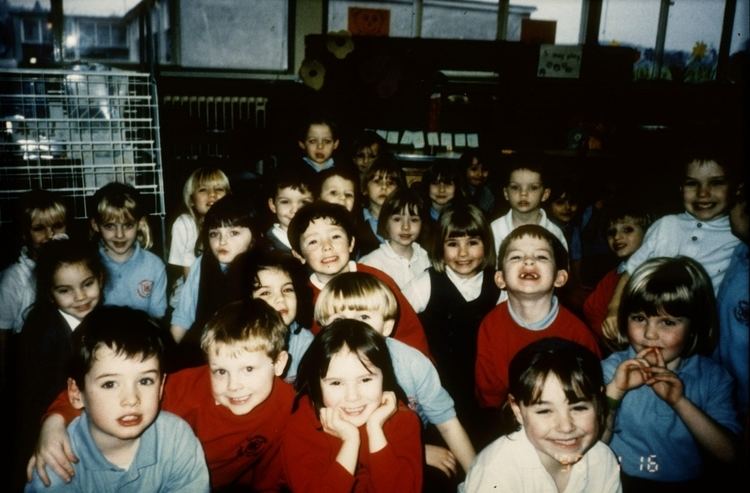Name Dunblane massacre | ||
 | ||
Coordinates 56°11′20″N 3°58′27″W / 56.1890°N 3.9743°W / 56.1890; -3.9743Coordinates: 56°11′20″N 3°58′27″W / 56.1890°N 3.9743°W / 56.1890; -3.9743 Date 13 March 1996 (1996-03-13)c. 9:35 a.m.–9:40 a.m. (GMT) Target Pupils and staff at Dunblane Primary School Weapons 9mm Browning HP pistol (x2)Smith & Wesson M19 .357 Magnum revolver (x2) | ||
Scotland dunblane school massacre 1996
The Dunblane school massacre took place at Dunblane Primary School near Stirling, Stirlingshire, Scotland, on 13 March 1996, when gunman Thomas Hamilton killed 16 children and one teacher before committing suicide. It remains the deadliest mass shooting in British history.
Contents
- Scotland dunblane school massacre 1996
- UK SCOTLAND DUNBLANE SCHOOL MASSACRE STILL OF VICTIMS
- Shooting
- Emergency response
- Perpetrator
- Gun control
- Criticism of the judiciary
- Books
- Television
- Newspapers
- Memorials
- Commemoration stone
- Musical tributes
- References

Public debate about the killings centred on gun control laws, including public petitions calling for a ban on private ownership of handguns and an official inquiry, which produced the 1996 Cullen Reports. In response to this debate, two new Firearms Acts were passed, which greatly restricted private ownership of firearms in Great Britain.

UK: SCOTLAND: DUNBLANE SCHOOL MASSACRE: STILL OF VICTIMS
Shooting

At about 8:15 a.m. on Wednesday 13 March 1996, Thomas Hamilton, aged 43, was seen scraping ice off his van outside his home at Kent Road in Stirling. He left soon afterwards and drove about 5 miles (8 km) north to Dunblane. He arrived on the grounds of Dunblane Primary School at around 9:30 a.m. and parked his van near a telegraph pole in the car park of the school. Hamilton cut the cables at the bottom of the telegraph pole, which served nearby houses, with a set of pliers before making his way across the car park towards the school buildings.

Hamilton headed towards the north-west side of the school to a door near toilets and the school gymnasium. After entering, he made his way to the gymnasium armed with four legally-held handguns—two 9mm Browning HP pistols and two Smith & Wesson M19 .357 Magnum revolvers. He was also carrying 743 cartridges of ammunition. In the gym was a class of twenty-eight Primary 1 pupils preparing for a PE lesson in the presence of three adult members of staff.

Before entering the gymnasium, it is believed Hamilton fired two shots into the stage of the assembly hall and the girls' toilet. Upon entering the gymnasium, as he was about to be confronted by Eileen Harrild, the PE teacher in charge of the lesson, he started shooting rapidly and randomly. He shot Harrild, who was injured in her arms and chest as she attempted to protect herself, and continued shooting into the gymnasium. Harrild stumbled into the open-plan store cupboard at the side of the gym along with several injured children. Gwen Mayor, the teacher of the Primary 1 class, was shot and killed instantly. The other adult present, Mary Blake, a supervisory assistant, was shot in the head and both legs but also managed to make her way to the store cupboard with several of the children in front of her.

From entering the gymnasium and walking a few steps, Hamilton had fired 29 shots with one of the pistols, killed one child, and injured several others. Four injured children had taken shelter in the store cupboard along with the injured Harrild and Blake. Hamilton then moved up the east side of the gym, firing six shots as he walked, and then fired eight shots towards the opposite end of the gym. He then went towards the centre of the gym, firing 16 shots at point-blank range at a group of children who had been incapacitated by his earlier shots.

A Primary 7 pupil who was walking along the west side of the gym building at the time heard loud bangs and screams and looked inside the gym. Hamilton shot in his direction and the pupil was injured by flying glass before running away. From this position, Hamilton fired 24 shots in various directions. He fired shots towards a window next to the fire exit at the south-east end of the gym, possibly at an adult who was walking across the playground, and then fired four more shots in the same direction after opening the fire exit door. Hamilton then exited the gym briefly through the fire exit, firing another four shots towards the cloakroom of the library, striking and injuring Grace Tweddle, another member of staff at the school.
In the mobile classroom closest to the fire exit where Hamilton was standing, Catherine Gordon saw him firing shots and instructed her Primary 7 class to get down onto the floor before Hamilton fired nine bullets into the classroom, striking books and equipment. One bullet passed through a chair where a child had been sitting seconds before. Hamilton then reentered the gym, dropped the pistol he was using, and took out one of the two revolvers. He put the barrel of the gun in his mouth, pointed it upwards, and pulled the trigger, killing himself. A total of 32 people sustained gunshot wounds inflicted by Hamilton over a 3–4-minute period, 16 of whom were fatally wounded in the gymnasium, which included Mayor and 15 of her pupils. One other child died later en route to hospital.
Emergency response
The first call to the police was made at 9:41 a.m. by the headmaster of the school, Ronald Taylor, who had been alerted by assistant headmistress Agnes Awlson to the possibility of a gunman on the school premises. Awlson had told Taylor that she had heard screaming inside the gymnasium and had seen what she thought to be cartridges on the ground, and Taylor had been aware of loud noises which he assumed to have been from builders on site that he had not been informed of. As he was on his way to the gym, the shooting ended and when he saw what had happened he ran back to his office and told deputy headmistress Fiona Eadington to call for ambulances, a call which was made at 9:43 a.m.
The first ambulance arrived on the scene at 9:57 a.m. in response to the call made at 9:43 a.m. Another medical team from Dunblane Health Centre arrived at 10:04 a.m. which included doctors and a nurse, who were involved in the initial resuscitation of the injured. Medical teams from the health centres in Doune and Callander arrived shortly after. The accident and emergency department at Stirling Royal Infirmary had also been informed of a major incident involving multiple casualties at 9:48 a.m. and the first of several medical teams from the hospital arrived at 10:15 a.m. Another medical team from the Falkirk and District Royal Infirmary arrived at 10:35 a.m.
By about 11:10 a.m., all of the injured had been taken to Stirling Royal Infirmary for medical treatment; one child died en route to the hospital. Upon examination, several of the patients were transferred to the District Royal Infirmary in Falkirk and some to the Royal Hospital for Sick Children in Glasgow.
Perpetrator
There had been several complaints to police regarding Hamilton's behaviour towards the young boys who attended the youth clubs he directed. Claims had been made of his having taken photographs of semi-naked boys without parental consent.
Hamilton had briefly been a Scout leader – initially, in July 1973, he was appointed assistant leader with the 4th/6th Stirling of the Scout Association. Later that year, he was seconded as leader to the 24th Stirlingshire troop, which was being revived. Several complaints were made about his leadership, including two occasions when Scouts were forced to sleep with Hamilton in his van during hill-walking expeditions. Within months, on 13 May 1974, Hamilton's Scout Warrant was withdrawn, with the County Commissioner stating that he was "suspicious of his moral intentions towards boys". He was blacklisted by the Association and thwarted in a later attempt he made to become a Scout leader in Clackmannanshire.
Hamilton claimed in letters that rumours about him led to the failure of his shop business in 1993, and in the last months of his life he complained again that his attempts to organise a boys' club were subject to persecution by local police and the scout movement. Among those he complained to were the Queen and the local Member of Parliament, Michael Forsyth. In the 1980s, another MP, George Robertson, who lived in Dunblane, had complained to Forsyth about Hamilton's local boys' club, which his son had attended. On the day following the massacre, Robertson spoke of having argued with Hamilton "in my own home".
On 19 March 1996, six days after the massacre, Hamilton's body was cremated "far away from Dunblane", according to the police spokesman.
Gun control
The Cullen Reports, the result of the inquiry into the massacre, recommended that the government introduce tighter controls on handgun ownership and consider whether an outright ban on private ownership would be in the public interest in the alternative (though club ownership would be maintained). The report also recommended changes in school security and vetting of people working with children under 18. The Home Affairs Select Committee agreed with the need for restrictions on gun ownership but stated that a handgun ban was not appropriate.
A small group, known as the Gun Control Network, was founded in the aftermath of the shootings and was supported by some parents of the victims of the Dunblane and Hungerford shootings. Bereaved families and their friends also initiated a campaign to ban private gun ownership, named the Snowdrop Petition, which gained 705,000 signatures in support and was supported by some newspapers, including the Sunday Mail, a Scottish tabloid newspaper whose petition to ban handguns raised over 500,000 signatures.
In response to this public debate, the then-current Conservative government of John Major introduced the Firearms (Amendment) Act 1997, which banned all cartridge ammunition handguns with the exception of .22 calibre single-shot weapons in England, Scotland and Wales, but following the 1997 General Election, the Labour government of Tony Blair introduced the Firearms (Amendment) (No. 2) Act 1997, banning the remaining .22 cartridge handguns as well. This left only muzzle-loading and historic handguns legal, as well as certain sporting handguns (e.g. "Long-Arms") that fall outside the Home Office definition of a "handgun" because of their dimensions. The ban does not affect Northern Ireland.
Criticism of the judiciary
Evidence of previous police interaction with Hamilton was presented to the Cullen Inquiry but was later sealed under a closure order to prevent publication for 100 years. The official reason for sealing the documents was to protect the identities of children, but this led to accusations of a coverup intended to protect the reputations of officials. Following a review of the closure order by the Lord Advocate, Colin Boyd, edited versions of some of the documents were released to the public in October 2005. Four files containing post mortems, medical records and profiles on the victims, as well as Hamilton's autopsy, remained sealed under the 100-year order to avoid distressing the relatives and survivors.
The released documents revealed that in 1991, following Hamilton's Loch Lomond summer camp, complaints were made to Central Scotland Police and were investigated by the Child Protection Unit. Hamilton was reported to the Procurator Fiscal for consideration of ten charges, including assault, obstructing police and contravention of the Children and Young Persons Act 1937. No action was taken.
Books
Two books – Dunblane: Our Year of Tears by Peter Samson and Alan Crow and Dunblane: Never Forget by Mick North (the father of one of the victims) – both give accounts of the massacre from the perspective of those most directly affected. On 1 March 2006, Creation Books released Predicate: The Dunblane Massacre — Ten Years After by Peter Sotos. Dunblane Unburied (2006, BookPublishingWorld, ISBN 1-905553-05-6) by Sandra Uttley takes a more controversial view of a "cover-up", casting doubt on the theory that Hamilton “acted alone”.
Television
On the Sunday following the shootings the morning service from Dunblane Cathedral, conducted by Rev. Colin MacIntosh, was broadcast live by the BBC. The BBC also had live transmission of the Memorial Service on 9 October 1996, also held at Dunblane Cathedral. A documentary "Crimes That Shook Britain" featured the massacre. The documentary Dunblane: Remembering our Children, which featured many of the parents of the children who had been killed, was broadcast by STV and ITV at the time of the first anniversary. At the time of the tenth anniversary in March 2006 two documentaries were broadcast. Channel 5 screened Dunblane — A Decade On and BBC Scotland showed Remembering Dunblane.
Newspapers
In 2009, the Sunday Express came under some criticism for its coverage of the survivors of the massacre.
Memorials
Two days after the shooting, a vigil and prayer session was held at Dunblane Cathedral which was attended by people of all faiths. On Mothering Sunday, on 17 March, Queen Elizabeth II and her daughter Anne, Princess Royal, attended a memorial service at Dunblane Cathedral.
Seven months after the massacre in October 1996, the families of the victims organised their own memorial service at Dunblane Cathedral, which more than 600 people attended, including Prince Charles who was representing the Royal Family. The service was broadcast live on BBC1 and conducted by James Whyte, a former Moderator of the General Assembly of the Church of Scotland. Television presenter Lorraine Kelly, who had befriended some of the victims' families whilst reporting on the massacre for GMTV, was a guest speaker at the service.
In August 1997, two varieties of rose were unveiled and planted as the centrepiece for a roundabout in Dunblane. The two roses were developed by Cockers Roses of Aberdeen; the 'Gwen Mayor' rose and 'Innocence' rose, in memory of the children killed. A snowdrop originally found in a Dunblane garden in the 1970s was renamed 'Sophie North' in memory of one of the victims of the massacre.
The gymnasium at the school was demolished on 11 April 1996 and replaced by a memorial garden. Two years after the massacre on 14 March 1998, a memorial garden was opened at Dunblane Cemetery, where Mayor and twelve of the slain children are buried. The garden features a fountain with a plaque of the names of those killed. Stained glass windows in memory of the victims were placed in three local churches, St Blane's and the Church of the Holy Family in Dunblane and the nearby Lecropt Kirk as well as at the Dunblane Youth and Community Centre.
The National Association of Primary Education commissioned a sculpture, "Flame for Dunblane", created by Walter Bailey from a single yew tree, which was placed in the National Forest, near Moira, Leicestershire.
Commemoration stone
In the nave of Dunblane Cathedral is a standing stone by the monumental sculptor Richard Kindersley. It was commissioned by the Kirk Session as the Cathedral's commemoration and dedicated at a service on 12 March 2001. It is a Clashach stone two metres high on a Caithness flagstone base. The quotations on the stone are by E. V. Rieu ("He called a little child to him..."), Richard Henry Stoddard ("...the spirit of a little child"), Bayard Taylor ("But still I dream that somewhere there must be The spirit of a child that waits for me") and W. H. Auden ("We are linked as children in a circle dancing").
Musical tributes
With the consent of Bob Dylan, the musician Ted Christopher wrote a new verse for "Knockin' on Heaven's Door" in memory of the Dunblane school children and their teacher. The recording of the revised version of the song, which included brothers and sisters of the victims singing the chorus and Mark Knopfler on guitar, was released on 9 December 1996 in the UK, and reached number 1. The proceeds went to charities for children. Pipe Sergeant Charlie Glendinning of the City of Washington Pipe Band (US) composed "Dunblane," a tune for bagpipes, which Bonnie Rideout arranged for two violins and viola. It was recorded on Rant, an album produced by Maggie's Music. Pipe Major Robert Mathieson of the Shotts and Dykehead Pipe Band composed a pipe tune in tribute, "The Bells of Dunblane."
